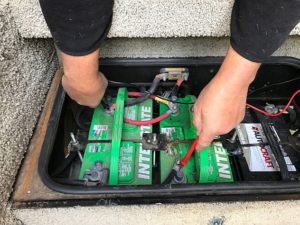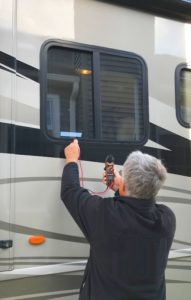What is covered in an RV inspection?
There are several different levels of an NRVIA inspection, ranging from a simple safety inspection to a premier inspection that reviews over 500 items in the RV. The one that you choose depends on why you are having an inspection done.
Let’s face it, recreational vehicles (RV’s) are rolling earthquakes. Even brand new out of the factory they are going to have one problem or another. If you are buying a new RV from a dealership, do NOT buy for price alone. Check their reviews for service after the sale. The relationship you form with your dealer can make a big difference in your RVing experience.
If you are buying a used RV from a dealer or individual, an inspection is a very good idea. The more an RV is used, the more wear and tear will be on the rig and the more problems that will turn up. Proper maintenance will help, but sometimes problems are hidden and will only be revealed when an inspector tests for that specific thing.
If you plan on traveling a lot, do not assume that any RV Dealership will work on your rig. RV Dealerships represent many different companies and don’t receive financial or advertising support from them the same way as a car dealership. They have to make financial decisions that are in the best interest of supporting their existing customers. That’s why so many restrict service to the customers who purchased from them.
Your NRVIA inspector has been trained in trouble shooting problems, and is required to complete 36 continuing education hours every year to maintain his certification. He can work on any problems you find on your RV but it is unethical for him to work on problems he discovers during an inspection.
If you are an experienced RVer, you may want a simple Safety and Use check which can take 3 hours or less. If you are new to RVing and just want someone to walk you through the rig, showing you how everything works and double checking the safety issues, this is the inspection for you.
If you are considering purchasing a used rig for a lot of traveling but not necessarily a full time lifestyle, you probably want a full inspection including all the items shown below. If you are purchasing an older rig, or plan to be living in it full time, you probably want a full inspection complete with a fluid analysis. This inspection can take 6 to 8 hours. Lab work for the fluid analysis can take up to a week to come back.
There is also value is having your rig inspected BEFORE the sale. A thorough inspection before the sale can alert a seller to potential problems he can fix before putting the rig on the market. This enables the seller to ask top dollar for his RV and give his buyer the peace of mind that he is getting a rig in good condition.

So what does an NRVIA inspector actually do?
The first thing your inspector will check is the VIN. He wants to be sure he is looking at the right vehicle. It sounds unlikely, but even dealers have been known to prep the wrong vehicle for sale. If you are buying something from out of state, you definitely want to know that the vehicle you are expecting to purchase is the one that has been presented for inspection.
The second thing your inspector will check are safety issues starting with the power systems. For example, a miswired power plug outlet or a screw driven in the wrong place could cause what is called a hot skin condition. This is a situation which may cause the skin of the RV to become electrically charged. Because the RV is sitting on wheels which ground it, you may not notice the problem until you are standing on the ground and touch a metal part of the RV. Your RV inspector will check for this condition before even entering the rig.
After performing a GFCI circuit test and polarity test, your inspector will check the installed alarms. Your smoke, LP gas and CO detectors will be checked both by instrument and by the installed alarm system itself. Your propane system will be checked for leaks, including the tank, water heater and furnace.
Your installed fire extinguisher will be checked to make sure they are the correct ones for your unit and that they are placed appropriately. A home fire extinguisher and an RV fire extinguisher are not the same thing. A towable unit should have at least one 5 BC extinguisher. Motorized units should have at least one 10 BC extinguisher.
An RV fire extinguisher is not designed to put out a fire, although it certainly can do so. It is meant to give the occupants of the unit the chance to escape. So the next thing your inspector will check is are your emergency exits. Except in the case of single use windows, your emergency exit windows should be easily accessible and fully functioning.
Your inspector will climb on the roof and closely examine the seals, joints and trim rails for damage or other points of water intrusion. All sealant must be inspected for proper usage. Different types of roofs require different types of sealant. If the proper one was not used, that will be an indication of a potential problem.
Other safety issues on the roof could include blocked vents, cracked AC shrouds or damaged TV antennas. Although these items may or may not cause a problem using the RV, they could indicate issues in the past that may have been covered up or could cause future problems.
Your inspector will also check:
• All slideouts, slide toppers and awnings and for proper functioning.
• Sidewalls including doors and windows for delamination and proper functioning.
• Frame and Running Gear for rust, damage or leaks.
• Wheels and Axel Assembly, including tire tread, sidewalls, and dates.
• Chassis and Undercarriage.
• Hitch, Hitch Receiver, 7-Pin Connector.
• Leveling System.
• 12 V DC Marker Lights, including the chassis turn signal and running lights.
• 12 V DC and 120 V AC Interior, Exterior, and Compartment Lights.
• Circuit Panel (Fuse) Box.
• Converter/Inverter/Battery System.
• All Appliances, including the Generator, Refrigerator, Air Conditioner(s), Cooktop/Oven, Microwave/Convection Oven, Cooktop Exhaust Fans, Washer/Dryer, Dishwasher, Electric Fireplace, Ceiling Fan(s) and In-house Vacuum System
• The Water Systems including the city water hookup, the onboard freshwater tank and pump, the wastewater system (gray and black tanks, lines and valves) and the drain cap.
• The interior and decor including the ceiling, walls, flooring, cabinets, drawers, doors, furniture, entertainment system.
• The bathroom sinks, toilet, shower/tub.
If the rig is motorized your inspector will offer to draw and send out for laboratory testing the fluids that your RV or Tow Vehicle uses such as engine oil, radiator coolant and transmission fluid. He can also draw oil and coolant from the generator, if equipped. If you are buying a 5th wheel trailer with a leveling system, the hydraulic fluid can also be analyzed. Fluid analysis may reveal potential problems with the engine or transmission generator of hydraulic systems and alert you to an upcoming repair.
If you would like to schedule an inspection, give us a call.
